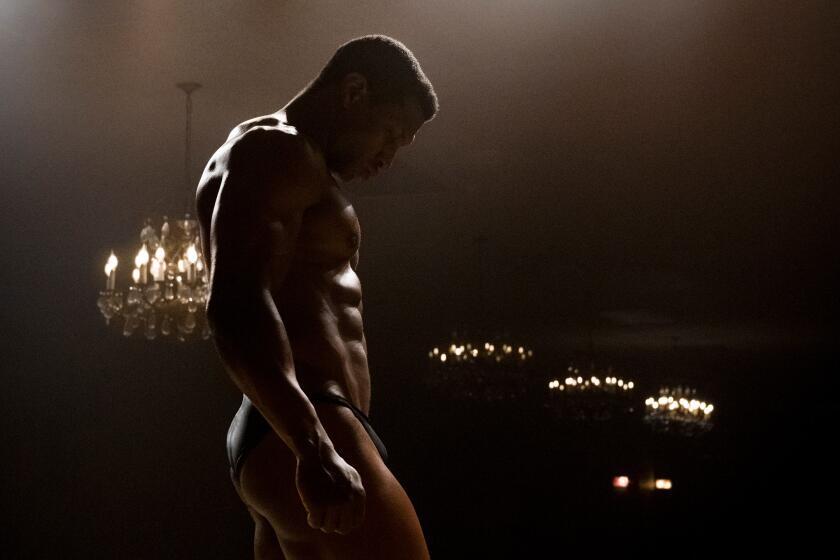A story of female athletes, told courts and all
- Share via
TORONTO — Seven years ago, Ward Serrill was introduced to Bill Resler, a warm and garrulous professor of tax law at the University of Washington who was about to begin his first year as head coach for the girls’ varsity basketball team at Seattle’s Roosevelt High School. He immediately saw cinematic potential. Resler had some unusual ideas about coaching, which he was about to put into practice for the first time.
To dispel fear of physical contact and promote aggressiveness, for example, Resler encourages his team to think of themselves as wild animals or forces of nature.
One year, they were a pack of wolves; the next, a tropical storm. The Roosevelt Roughriders aren’t urged to their best, they’re told to hunt, kill and devour their opponents.
“Bill sat across the kitchen table telling stories, and 45 minutes later I was still laughing,” Serrill recalled. “Then I went to a game, and there were just sparks coming off these girls. They had more unbridled joy and enthusiasm than I’d seen in any gym. So, I naively walked into a practice one day and started filming without any idea of what I was going to do.”
Serrill finished his documentary, “The Heart of the Game,” just a few days before it premiered at the Toronto Film Festival this week. What had started as a one-year project about how girls approach sports in a more team-oriented way than boys, wound up chronicling the rise of a remarkable team and the compelling story of now-19-year-old Darnellia Russell, the team’s star player.
After the film’s second public screening in Toronto, where it was well received (Miramax has acquired U.S. distribution rights), Serrill, Resler and Russell, who graduates from North Seattle Community College next year, met me at the Four Seasons to talk about the making of the film.
During the first year, Serrill would shoot three or more practices and games per week, documenting their transformation from an average team into a self-governing group known for its fierceness and unpredictability on the court. But when Russell walked onto the court at the start of her freshman year (she never played J.V.), something told Serrill that she was the subject his movie had been waiting for.
One of the few black players on the team, Russell struggled to adapt to her new school but soon blossomed as a player, amassing a shoe boxful of letters from Division I college recruiters by her junior year. She also led the Roughriders to the state playoffs four times, which, each time, they lost by a fluke. When unforeseen circumstances prompted Russell to temporarily quit school before the end of her senior year, Serrill thought his story had concluded.
“I just couldn’t keep doing it. I thought I could build a pretty powerful story in four years and then doing a little epilogue about some of the girls.”
But Russell unexpectedly returned to school a year later. Once again, the lure of seeing the Roughriders through the state playoffs, especially after Russell’s return, proved irresistible.
“When Darnellia started to turn her life around, that was Act 3.” However, Russell soon discovered she had been ruled ineligible to play by the Washington Interscholastic Activities Assn., the state’s governing junior high and high school activities association. So Serrill and Resler took the case to court.
Without giving away details of the case or of Russell’s particular circumstances, it’s difficult to convey how the protracted and hotly contested court battle seemed to take on issues larger than Russell’s right to play. “It eventually became a civil rights case,” Serrill says. “At one point, it struck me that an African American girl’s fate was being decided by these big white guys. Her fate was being decided by males at every turn.”
Eventually, Russell graduated from Roosevelt High School with honors but with no scholarship offers from major universities. To Resler and Serrill, Russell’s experiences are indicative of a degree of an institutionalized sexism that still affects women’s sports.
This idea is echoed by the experiences of two other subjects in the film, 96-year-old Maud Lepley, who became a girls’ basketball coach in 1920 (when girls were obligated by law to play a restrictive version of the game to avoid over-exercise and injury), and Joyce Walker, now a coach at nearby rival Garfield High School who, after the passage of Title IX (which granted equal funding to girls athletics in schools), became an Olympic basketball player and the second woman to play for the Harlem Globetrotters.
Resler remains optimistic about Russell’s chances for a scholarship to a major university -- she has one more year of community college eligibility -- as he is for the future of the game.
“I feel that in the next five years, college girls basketball and high school girls basketball are going to be major sports,” he says. “The girls have gotten very good. Some years, we were more popular than the boys’ teams. And I attribute it to the fact that that the girls fight tooth and claw.... Last year we were piranhas and said things like ‘Tear out their flesh!’ Some people will say this is wrong, you shouldn’t teach young girls to act like this. But that’s just sexist. I think we’re going to be tigers next year. Tigers are beautiful, and tigers are savage.”
*
Times film critic Chocano can be e-mailed at carina.chocano@latimes.com.
More to Read
Only good movies
Get the Indie Focus newsletter, Mark Olsen's weekly guide to the world of cinema.
You may occasionally receive promotional content from the Los Angeles Times.









